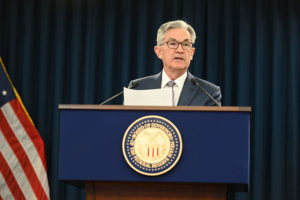
FOMC Chair Powell answers a reporter’s question at the March 3, 2020 press conference. Photo courtesy of the Federal Reserve.
The Federal Reserve has announced two new interventions into the corporate debt market. The first is the Primary Market Corporate Credit Facility (PMCCF) and the second is the Secondary Market Corporate Credit Facility (SMCCF). Here’s how The New York Times describes the plans’ operations:
The Fed’s plan to bolster the corporate bond market will work through two new programs established using the Fed’s emergency lending powers. They should help market functioning while allowing companies to stay afloat.
One of them, the Primary Market Corporate Credit Facility, is open to investment-grade companies and will provide bridge financing of four years, according to the Fed’s release. The Fed will create a special-purpose vehicle that will both buy bonds and extend loans.
The program defers interest payments on that bridge financing “for six months, extendable at the discretion of the Board of Governors” to get companies through the worst of the coronavirus period. But the support comes with restrictions — companies taking that option are not allowed to buy back shares or pay out dividends, both of which eat into a firm’s cash position.
The other would purchase already-issued debt, and the Fed said together the programs would “support credit to large employers.”
From his column at Bloomberg, former Minneapolis Fed President Narayana Kocherlakota explains his view on the two plans, supporting the secondary market plan, but panning the first. He writes:
This morning, the Federal Reserve announced two entirely novel interventions in the corporate debt market: the Primary Market Corporate Credit Facility (PMCCF) and the Secondary Market Corporate Credit Facility (SMCCF). If used appropriately, the latter is a smart and defensible use of central bank power to stabilize liquidity conditions in a key financial market. The former is an indefensible attempt by the Fed and the administration to sidestep Congress.
Consider where we are. The spreads on corporate bonds have widened markedly in the past few weeks. Like all movements in yields, this one has two sources. First, corporate bonds have gotten less liquid: Buyers have rising concerns that, if they needed cash, they wouldn’t be able to resell the bonds quickly without taking a big loss. Second, corporate bonds have gotten riskier: buyers are increasingly worried that corporations won’t have the cash flow to repay their debts.
This liquidity problem is one that the Fed can and should fix. The Fed never needs to worry about reselling any asset. So it can use its ability to print money to tell corporate buyers: look, we’ll always be here to buy your assets. This can eliminate any fear on the part of corporate bond buyers that they won’t be able to resell their assets quickly. As a result, corporations will be able to borrow at a lower interest rate.
The risk problem is entirely different. Given the challenges in the economy posed by the coronavirus and the appropriate public-health response, corporations face a great deal of risk. It makes sense, because of that risk, that their bonds should trade at a lower price and higher yield. The Fed has no special epidemiological powers or knowledge that will allow it to eliminate or even understand this risk.
Kocherlakota’s view on the primary lending facility is sensible, but the Fed is doing much more than just providing liquidity into the secondary market for corporates. You can almost be guaranteed they are overpaying for corporates in this climate.
